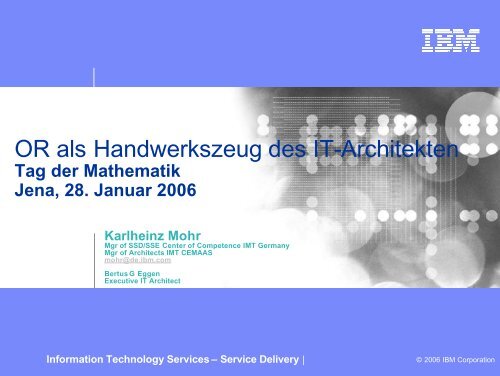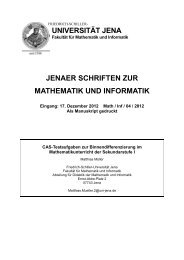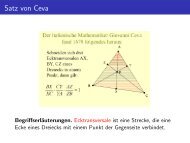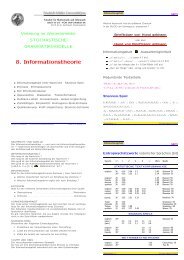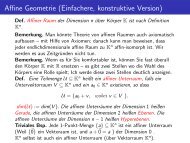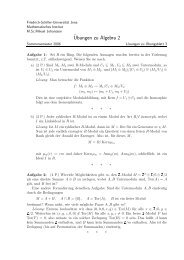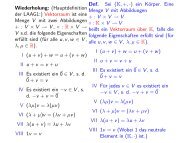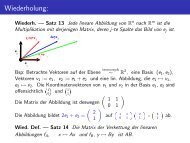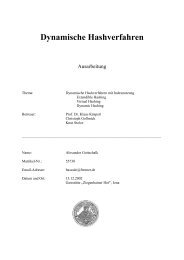c - Fakultät für Mathematik und Informatik
c - Fakultät für Mathematik und Informatik
c - Fakultät für Mathematik und Informatik
You also want an ePaper? Increase the reach of your titles
YUMPU automatically turns print PDFs into web optimized ePapers that Google loves.
OR als Handwerkszeug des IT-Architekten<br />
Tag der <strong>Mathematik</strong><br />
Jena, 28. Januar 2006<br />
Karlheinz Mohr<br />
Mgr of SSD/SSE Center of Competence IMT Germany<br />
Mgr of Architects IMT CEMAAS<br />
mohr@de.ibm.com<br />
Bertus G Eggen<br />
Executive IT Architect<br />
Information Technology Services – Service Delivery | © 2006 IBM Corporation
Information Technology Services – Service Delivery<br />
ertus Eggen<br />
xecutive IT Architect<br />
ember of IBM Academy of Technology<br />
Education<br />
1982-1989: Technische Universität Braunschweig; Diplom (Master) in Mathematics<br />
Career<br />
2000: Executive IT Architect<br />
1995: Senior IT Architect<br />
1994: Fo<strong>und</strong>ing member of ESM Knowledge Network's Core Team, responsable for<br />
research and development<br />
1990-1993: Support of VOLKSWAGEN regarding Application Development,<br />
Networking and Systems Management on UNIX and AIX<br />
1990: Joined IBM as Systems Engineer in Braunschweig, Germany<br />
1987-1990: "Grafik <strong>und</strong> Datenverarbeitung GbR", Owner of application development<br />
company (see also next section)<br />
Publications<br />
"Numerische Methoden im CAD" (“Numerical Methods in Computer Aided Design"),<br />
Vieweg<br />
"System Management Design Samples - A Management Summary", IBM Redbook<br />
"System Management Design Guidelines", IBM Redbook<br />
Key Engagements<br />
1997-2001: DKV (Deutsche Krankenversicherung, ITERGO), Cologne, Germany;<br />
Lead Architect/Project; Leader/Consulting Architect<br />
1997: Germany Stock Exchange, Frankfurt, Germany; Lead Architect/Project Leader<br />
1996: Daimler Benz Aerospace, Hamburg, Germany; Lead Architect/Project Leader<br />
1996: Boeing, Seattle, Washington, USA; Leading Architect/Mentor<br />
1993-1996: LIT (Landesamt <strong>für</strong> Informationstechnik), Berlin Germany; Leading<br />
Architect<br />
Recognition<br />
2000: Elected as Member, IBM Academy of Technology<br />
1999: Engagement Excellence Award, DKV Engagement, Cologne, Germany<br />
1998: Team Excellence Award, DKV Engagement, Cologne, Germany<br />
1995: Team Excellence Award, Fiscus Engagement, Hannover, Germany<br />
1995: Engagement Excellence Award, LIT Engagement, Berlin, Germany<br />
1994: Software ExcellenceAward, Systems Management Assessment Workshop<br />
Karlheinz Mohr<br />
Mgr of SSD/SSE IMT Germany & CEMAAS<br />
Business Unit Technical Leader<br />
Education<br />
Career<br />
1981-1986 Uni Heidelberg, Dipl.-Math<br />
1977-1980 Uni Hamburg, Versicherungs <strong>Mathematik</strong><br />
2001-2004 Competency&Professional Development Execeutive EMEA<br />
200-2001 Manager Fo<strong>und</strong>ation IBM Germany<br />
1998 Manager, Security Services and Systemsmanagement<br />
1994 Project Lead, Chemistry Applications<br />
1990 Speech Product Development Manager, ELBU<br />
1988, Research Staff meber at IBM TJ Watson Research Lab<br />
1986, Scientific Staff Member, IBM Heidelberg<br />
1981-1986 MOHR EDV -Arbeiten and IBM Science Center Heidelberg<br />
1979, 1980 Summerstudent at IBM with several customers<br />
Recognition<br />
1990 Patent Application Award<br />
1988 First Patent Application Award<br />
1987 Outstanding Technical Achievement Award<br />
Tag der <strong>Mathematik</strong>, Uni Jena | Slide 2 © 2006 IBM Corporation
Agenda<br />
Information Technology Services – Service Delivery<br />
� What is IT Consulting / IT Architecture<br />
� What is Operations Research ?<br />
� General Approach<br />
� Some Areas of Operations Research<br />
� Example<br />
� References<br />
Tag der <strong>Mathematik</strong>, Uni Jena | Slide 3 © 2006 IBM Corporation
Information Technology Services – Service Delivery<br />
IT Consultants and IT Architects work in the early<br />
phases of a project.<br />
Phase 1:<br />
Solution Strategy<br />
Selection<br />
Phase 4:<br />
Deliver Service<br />
Assessment<br />
Strategy<br />
Selection<br />
Operation<br />
Manage Delivery<br />
Architecture Data<br />
Processes<br />
D Design<br />
Develop<br />
Deploy<br />
HLDesign<br />
Tag der <strong>Mathematik</strong>, Uni Jena | Slide 4 © 2006 IBM Corporation<br />
Org<br />
Phase 2:<br />
Design Solution<br />
Phase 3:<br />
Implement Solution
Information Technology Services – Service Delivery<br />
The roles do overlap regarding the time in the<br />
solution life cycle.<br />
Priority of Role<br />
Consultants Architects Specialists<br />
Time in Life Cycle<br />
Tag der <strong>Mathematik</strong>, Uni Jena | Slide 5 © 2006 IBM Corporation
IT Consultant<br />
Information Technology Services – Service Delivery<br />
� Works „high and early“:<br />
Leads in phase 1 and 2<br />
Consults and develops strategies<br />
Skill Depth<br />
Skill range<br />
Tag der <strong>Mathematik</strong>, Uni Jena | Slide 6 © 2006 IBM Corporation
IT Architect<br />
Information Technology Services – Service Delivery<br />
� Leads in phase 2 and 3<br />
Develops the the complete solution<br />
„Thinks in the next larger context“<br />
Skill depth<br />
Skill range<br />
Tag der <strong>Mathematik</strong>, Uni Jena | Slide 7 © 2006 IBM Corporation
Information Technology Services – Service Delivery<br />
What is Operations Research ?<br />
Some „Definitions“<br />
� „Operations Research is part of applied<br />
Mathematics.“<br />
� „Operations Research (OR) is the use of the<br />
scientific methodology in studying systems whose<br />
design or operation require human decision making.<br />
.... OR is interdisciplinary in nature, drawing on (and<br />
contributing to) the techniques from many fields,<br />
including the mathematical sciences, engineering,<br />
economics and the physical sciences.“ 1<br />
� „Application of quantitative methods to prepare<br />
optimal decisions“ 2<br />
u „OR is application of scientific thinking to real<br />
life problems.“<br />
Sources:<br />
1 http://www.or.ncsu.edu/Overview.dir/overview.<br />
2 Translated from [1]<br />
Tag der <strong>Mathematik</strong>, Uni Jena | Slide 8 © 2006 IBM Corporation
Information Technology Services – Service Delivery<br />
What is Operations Research ?<br />
History<br />
Blaise Pascal<br />
(19.6.1623 - 19.8.1662)<br />
Carl Friedrich Gauß<br />
(30.4.1777 - 23.2.1855)<br />
His approaches to gambling<br />
games are the base for Game<br />
Theory which today is the<br />
framework for decision support in<br />
terms of tactic and strategy.<br />
Wanting to describe the tracks of<br />
asteroids, he invented calculus...<br />
The distribution function<br />
introduced byand later named after<br />
him is one of the most important<br />
formula in statistics.<br />
Leonhard Euler<br />
(15.4.1707 - 18.9.1783)<br />
Agner Krarup Erlang<br />
(1.1.1878 - 3.2.1929)<br />
His work on the problem of „The Seven Bridges of<br />
Königsberg“ was the fo<strong>und</strong>ationof the theory of<br />
graphs,<br />
which is the base for many structural or topological<br />
approaches.<br />
By studying a village telephone exchange he worked<br />
out a formula, nowknown as Erlang's formula, to<br />
calculate the fraction of callers attempting to call<br />
someone outside the village that must wait because all<br />
of the lines are busy.<br />
The mathematics <strong>und</strong>erlying today's complex<br />
telephone networks is still based on Erlang‘s work.<br />
The term „Operations Research“ appeared in the 1950ies and covers a broad range<br />
of scientific topics related to decision support.<br />
Tag der <strong>Mathematik</strong>, Uni Jena | Slide 9 © 2006 IBM Corporation
Information Technology Services – Service Delivery<br />
When to use Operations Research ?<br />
� In general<br />
Decision Support<br />
Describe problems in a structured manner<br />
To find quantitative answers to problems<br />
� Especially<br />
Analysis of problems and results<br />
Design of solutions<br />
Determine stable estimations<br />
Preparation of interviews and test cases<br />
Tag der <strong>Mathematik</strong>, Uni Jena | Slide 10 © 2006 IBM Corporation
Information Technology Services – Service Delivery<br />
General Approach in OR<br />
„Real World“<br />
„Model World“<br />
Picture based on [1]<br />
Real Real Problem<br />
Mathematical<br />
Model Model<br />
Solution for forReal Real<br />
Problem<br />
Abstraction Interpretation<br />
Description:<br />
„Analysis“<br />
Calculation<br />
If abstraction and interpretation do not match, a<br />
solution for one problem leads to solutions for other<br />
problems !<br />
Model Model Solution<br />
Solution:<br />
„Design"<br />
Tag der <strong>Mathematik</strong>, Uni Jena | Slide 11 © 2006 IBM Corporation<br />
!<br />
(This is a bless AND a curse.)
Information Technology Services – Service Delivery<br />
Analogy: Abstraction and Interpretation<br />
This is<br />
Blue This is<br />
Red<br />
This is<br />
Grey<br />
Tag der <strong>Mathematik</strong>, Uni Jena | Slide 12 © 2006 IBM Corporation
Information Technology Services – Service Delivery<br />
Areas of OR: Probabilities and Statistics<br />
Are the results of my<br />
evaluation or ranking<br />
significant ?<br />
?<br />
0,14<br />
0,12<br />
0,1<br />
0,08<br />
0,06<br />
0,04<br />
0,02<br />
0<br />
1 2 3 4 5 6 7 8 9 10 11 12 13 14 15 16 17 18 19 20<br />
n<br />
2<br />
2 ( ni<br />
− np)<br />
χ < α<br />
np<br />
= ∑<br />
i=<br />
1<br />
Tag der <strong>Mathematik</strong>, Uni Jena | Slide 13 © 2006 IBM Corporation<br />
Density<br />
Probability<br />
!
Information Technology Services – Service Delivery<br />
Areas of OR: Queueing Theory<br />
How many<br />
� Employees<br />
� Server<br />
� Replica<br />
� ...<br />
do I need ?<br />
C(<br />
c,<br />
t)<br />
c<br />
t<br />
c!<br />
c<br />
∑ −<br />
= c<br />
1 n<br />
t<br />
t<br />
+ ( 1−U<br />
)<br />
c!<br />
n=<br />
0 n!<br />
Client<br />
Call Center<br />
Help Desk<br />
⎛ C(<br />
c,<br />
t)<br />
⎞<br />
ERT = ES⎜1<br />
+ ⎟<br />
⎝ c(<br />
1−U<br />
) ⎠<br />
Tag der <strong>Mathematik</strong>, Uni Jena | Slide 14 © 2006 IBM Corporation
Information Technology Services – Service Delivery<br />
Areas of OR: Graphs<br />
Köln<br />
4 MBit<br />
Stuttgart<br />
2 MBit<br />
7 MBit<br />
Frankfurt<br />
6 MBit<br />
Hamburg<br />
5 MBit<br />
2 MBit<br />
10 MBit<br />
5 MBit<br />
München<br />
Berlin<br />
v 1<br />
8<br />
2<br />
v 4<br />
5<br />
v 3<br />
2<br />
v 2<br />
7<br />
5<br />
3<br />
3<br />
v 6<br />
Tag der <strong>Mathematik</strong>, Uni Jena | Slide 15 © 2006 IBM Corporation<br />
v 5<br />
Nr. Vorgangsname Dauer<br />
1<br />
2<br />
3<br />
4<br />
5<br />
6<br />
V1<br />
V2<br />
V3<br />
V4<br />
V5<br />
V6<br />
1 Tag<br />
1 Tag<br />
1 Tag<br />
1 Tag<br />
1 Tag<br />
1 Tag<br />
Die 01. Mai Mit 02. Mai Don 03. Mai Fre 04. Mai Sam 05. Mai Son 06. Mai Mon 07. Mai<br />
0 6 12 18 0 6 12 18 0 6 12 18 0 6 12 18 0 6 12 18 0 6 12 18 0 6 12
Information Technology Services – Service Delivery<br />
Areas of OR: Queueing Systems/Netplan Technique<br />
How long does it take to<br />
make a bar of gold ?<br />
The farm makes<br />
wheat<br />
he mill needs wheat<br />
nd makes flour<br />
The Store needs gold<br />
The coal mine needs food and makes coal<br />
The ore mine needs foo<br />
and makes gold ore<br />
The bakery needs flour<br />
and water and makes<br />
bread<br />
The melt needs coal and<br />
ore and makes gold bars<br />
Tag der <strong>Mathematik</strong>, Uni Jena | Slide 16 © 2006 IBM Corporation
Information Technology Services – Service Delivery<br />
Other areas of OR<br />
Linear Programming<br />
Integer Programming<br />
Transportation<br />
Dynamics Optimization<br />
Non-Linear Optimization<br />
Decision Theory<br />
Game Theory<br />
Simulation<br />
Optimal Storage<br />
...<br />
The trick is re-combination of the areas...<br />
Tag der <strong>Mathematik</strong>, Uni Jena | Slide 17 © 2006 IBM Corporation
Information Technology Services – Service Delivery<br />
Example: System Design/Analysis<br />
� Problem<br />
Usually system designs are incomplete or inconsistent (or: „not good<br />
enough“).<br />
The methods currently used do not have any metrics „built in“ u no<br />
optimization possible<br />
The available tools are always depending on a specific method.<br />
� Related business issue<br />
It is very cost intensive to create high quality<br />
GP is lower than possible<br />
� Summary<br />
Approach to describe/evaluate system designs, e.g.:<br />
Process Models<br />
Data Models<br />
E2E Architectures<br />
...<br />
Based on discrete math (the same stuff we are using for VLSI design) and<br />
some algebraic stuff<br />
Tag der <strong>Mathematik</strong>, Uni Jena | Slide 18 © 2006 IBM Corporation
Component I<br />
Information Technology Services – Service Delivery<br />
Every entity in a system design can be decomposed to entities of the<br />
same type („children“).<br />
Subcomponent I<br />
Subcomponent II<br />
Subsubcomponent<br />
Subcomponent III<br />
Level 2 = Activity ?<br />
Level 1 = Task ?<br />
Level 0 = Process ?<br />
Subcomponent I<br />
Component I<br />
Subcomponent III<br />
Subcomponent II<br />
Subsubcomponent<br />
Tag der <strong>Mathematik</strong>, Uni Jena | Slide 19 © 2006 IBM Corporation
Information Technology Services – Service Delivery<br />
An entities properties depend on the properties of its children.<br />
Subcomponent II:<br />
Property Value<br />
Scalability XXX<br />
Availability XXX<br />
Duration 9<br />
Cost XXX<br />
In general, „sum“ is a function:<br />
decomposes to<br />
ai, n = f ( a1,<br />
n,...,<br />
ai−1,<br />
n,<br />
ai+<br />
1,<br />
n,...,<br />
am,<br />
n,<br />
ai,<br />
n−1,<br />
1,...,<br />
ai,<br />
n−1,<br />
k<br />
Properties of<br />
same entity<br />
* the last level components are building a linear sequence (see prev. foil)<br />
is sum * Aggregation:<br />
of<br />
Same<br />
property of<br />
all children<br />
)<br />
Property Value<br />
Scalability XXX<br />
Availability XXX<br />
Duration 3<br />
Cost XXX<br />
Property Value<br />
Scalability XXX<br />
Availability XXX<br />
Duration 5<br />
Cost XXX<br />
Property Value<br />
Scalability XXX<br />
Availability XXX<br />
Duration 1<br />
Cost XXX<br />
Tag der <strong>Mathematik</strong>, Uni Jena | Slide 20 © 2006 IBM Corporation
Information Technology Services – Service Delivery<br />
To determine the aggregation completely and consistently the system‘s description has to<br />
cover three classes of information: Hierarchies, Relationships and Graphs<br />
Hierarchies:<br />
� Processes<br />
� Architectural<br />
components<br />
� Data Entities<br />
� Organizational units<br />
(„Org Charts“)<br />
� Roles<br />
� ...<br />
(Decomposition-)<br />
Trees describing<br />
„set-like“<br />
properties<br />
Hier Namen eingeben<br />
Hier Titel eingeben<br />
Kommentar 1<br />
Kommentar 2<br />
Relationsships:<br />
� Who is responsable for<br />
what ?<br />
� Which process is<br />
applied to what<br />
component ?<br />
� Who has which role ?<br />
� ...<br />
Matrices describing<br />
relational properties<br />
1 1 1 1 1 1 1<br />
1 0 1 0 1 0 1<br />
1 0 0 0 1 0 0<br />
0 1 0 1 0 1 0<br />
0 1 1 1 0 1 1<br />
0 0 1 0 0 0 1<br />
Graphs:<br />
� Workflows<br />
� Dependencies<br />
� Interactions<br />
� ...<br />
general general<br />
general<br />
Hier Namen eingeben<br />
Hier Titel eingeben<br />
Kommentar 1<br />
Kommentar 2<br />
Hier Namen eingeben<br />
Hier Titel eingeben<br />
Kommentar 1<br />
Kommentar 2<br />
Hier Namen eingeben<br />
Hier Titel eingeben<br />
Kommentar 1<br />
Kommentar 2<br />
directed Graphs<br />
describing<br />
structural/topological<br />
properties<br />
Tag der <strong>Mathematik</strong>, Uni Jena | Slide 21 © 2006 IBM Corporation
Information Technology Services – Service Delivery<br />
Aggregation of metrics<br />
serial case<br />
parallel case<br />
Scalability<br />
f1, 1 f1, 2<br />
f1<br />
o ( g1(<br />
n))<br />
o(<br />
g2<br />
( n))<br />
o g ( n)<br />
+ g<br />
( 1 2<br />
Availability 1 a 2 a 1 2 a a<br />
Duration 1 d 2 d 1 2 d d +<br />
Cost 1 c 2 c 1 2 c c +<br />
Scalability<br />
* “o(g)“ means Landau Symbol<br />
o ( g1(<br />
n))<br />
o(<br />
g2<br />
( n))<br />
Availability 1 a 2 a<br />
Duration 1 d 2<br />
( n))<br />
o ( g1(<br />
n)<br />
+ g2(<br />
n))<br />
1− ( 1−<br />
a1) * ( 1−<br />
a2)<br />
d ) , d<br />
max( 1 2 d<br />
Cost 1 c 2 c 1 2 c c +<br />
Tag der <strong>Mathematik</strong>, Uni Jena | Slide 22 © 2006 IBM Corporation
References<br />
Information Technology Services – Service Delivery<br />
[1] Werner Zimmermann „Operations Research -<br />
Quantitative Methoden zur<br />
Entscheidungsvorbereitung“<br />
Oldenbourg, 1999<br />
[2] Donald E. Knuth "The Art of Computer<br />
Programming", Vol. 1-3<br />
Addison Wesley, 1997<br />
[3] Simon Singh "Fermat's Last Theorem" Fourth Estate, 1997<br />
[4] Bronstein, I.N. and K.A.<br />
Semendyayev<br />
"Handbook of Mathematics" Verlag Harri Deutsch, 1985<br />
[5] Tom DeMarco "The Deadline" Dorset House Publishing, 1997<br />
Tag der <strong>Mathematik</strong>, Uni Jena | Slide 23 © 2006 IBM Corporation
Information Technology Services – Service Delivery<br />
Online References<br />
„Operations Research at NCSU“<br />
http://www.or.ncsu.edu/Overview.dir/overview.html<br />
„Mathematics Archives - Lessons and Tutorials“<br />
http://archives.math.utk.edu/tutorials.html<br />
„Dictionary of Algorithms, Data Structures, and Problems “<br />
http://hissa.nist.gov/dads/<br />
„IBM Research - Operations Research“<br />
http://www.research.ibm.com/math/OpResearch/index.html<br />
„IBM Research - Ponder This/Monthly Challenge“<br />
http://www.research.ibm.com/ponder/<br />
„Management Science Techniques“<br />
http://www.cs.adfa.edu.au/teaching/studinfo/mst2/<br />
Tag der <strong>Mathematik</strong>, Uni Jena | Slide 24 © 2006 IBM Corporation
Information Technology Services – Service Delivery<br />
An old fashioned slogan...<br />
Think.<br />
Tag der <strong>Mathematik</strong>, Uni Jena | Slide 25 © 2006 IBM Corporation


